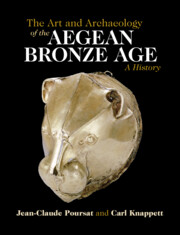Refine search
Actions for selected content:
23 results
4 - Potnia of the Labyrinth, Initiation of the King, and the Triple Sacrifice
-
- Book:
- Myth, Ritual, and Society in Mycenaean Anatolia
- Published online:
- 18 July 2025
- Print publication:
- 07 August 2025, pp 131-161
-
- Chapter
- Export citation
2 - Mycenaean and Vedic Sacrificial Posts
-
- Book:
- Myth, Ritual, and Society in Mycenaean Anatolia
- Published online:
- 18 July 2025
- Print publication:
- 07 August 2025, pp 47-66
-
- Chapter
- Export citation
7 - Golden Fleeces
-
- Book:
- Myth, Ritual, and Society in Mycenaean Anatolia
- Published online:
- 18 July 2025
- Print publication:
- 07 August 2025, pp 238-272
-
- Chapter
- Export citation
5 - Mitannian and Anatolian Triads
-
- Book:
- Myth, Ritual, and Society in Mycenaean Anatolia
- Published online:
- 18 July 2025
- Print publication:
- 07 August 2025, pp 162-193
-
- Chapter
- Export citation
1 - A Mycenaean Ritual and Its Cult Language
-
- Book:
- Myth, Ritual, and Society in Mycenaean Anatolia
- Published online:
- 18 July 2025
- Print publication:
- 07 August 2025, pp 8-46
-
- Chapter
- Export citation
3 - Mycenaean Leaders in the Context of Indo-European and Indo-Iranian Society and Ritual
-
- Book:
- Myth, Ritual, and Society in Mycenaean Anatolia
- Published online:
- 18 July 2025
- Print publication:
- 07 August 2025, pp 67-130
-
- Chapter
- Export citation
11 - Asian Goddesses and Bees
- from Part III - Anatolian and Aeolian Myth and Cult
-
- Book:
- Aeolic and Aeolians
- Published online:
- 21 November 2024
- Print publication:
- 21 November 2024, pp 317-343
-
- Chapter
- Export citation
16 - Bee and Bird, Linear B Du-ma/Da-ma, Luvo-Hittite Dammara-, and Artemis/Artimis/Artamis
- from Part III - Anatolian and Aeolian Myth and Cult
-
- Book:
- Aeolic and Aeolians
- Published online:
- 21 November 2024
- Print publication:
- 21 November 2024, pp 482-518
-
- Chapter
- Export citation
10 - Boeotian Foundation Mûthoi: From Dioscuri to Cabiri
- from Part II - Aeolian Origins in Myth
-
- Book:
- Aeolic and Aeolians
- Published online:
- 21 November 2024
- Print publication:
- 21 November 2024, pp 277-314
-
- Chapter
- Export citation
5 - Aeolian Patronymics and the Mycenaean Hekwetai
- from Part I - Aeolian and Aeolic
-
- Book:
- Aeolic and Aeolians
- Published online:
- 21 November 2024
- Print publication:
- 21 November 2024, pp 88-141
-
- Chapter
- Export citation
17 - Conclusion
- from Part III - Anatolian and Aeolian Myth and Cult
-
- Book:
- Aeolic and Aeolians
- Published online:
- 21 November 2024
- Print publication:
- 21 November 2024, pp 519-552
-
- Chapter
- Export citation
6 - Mycenaean Epíkouros
- from Part I - Aeolian and Aeolic
-
- Book:
- Aeolic and Aeolians
- Published online:
- 21 November 2024
- Print publication:
- 21 November 2024, pp 142-176
-
- Chapter
- Export citation
15 - Honey and Theogonies: The West Face of Sipylus
- from Part III - Anatolian and Aeolian Myth and Cult
-
- Book:
- Aeolic and Aeolians
- Published online:
- 21 November 2024
- Print publication:
- 21 November 2024, pp 450-481
-
- Chapter
- Export citation
12 - Ephesian Artemis’ “Breasts” and the Hittite Kurša
- from Part III - Anatolian and Aeolian Myth and Cult
-
- Book:
- Aeolic and Aeolians
- Published online:
- 21 November 2024
- Print publication:
- 21 November 2024, pp 344-374
-
- Chapter
- Export citation
20 - Reconstructing a Prehistoric Writing System
- from Part IV - Empirical Approaches
-
-
- Book:
- The Cambridge Handbook of Historical Orthography
- Published online:
- 28 September 2023
- Print publication:
- 12 October 2023, pp 395-416
-
- Chapter
- Export citation
3 - Mycenaean Greek Worship in Minoan Territory
-
-
- Book:
- The Local Horizon of Ancient Greek Religion
- Published online:
- 06 April 2023
- Print publication:
- 13 April 2023, pp 67-104
-
- Chapter
- Export citation
3 - Mycenaean Greek Worship in Minoan Territory
-
-
- Book:
- The Local Horizon of Ancient Greek Religion
- Published online:
- 06 April 2023
- Print publication:
- 13 April 2023, pp 67-104
-
- Chapter
- Export citation
2 - Language Change
-
- Book:
- Place Names
- Published online:
- 02 March 2023
- Print publication:
- 09 March 2023, pp 24-45
-
- Chapter
- Export citation
2 - Early Iron Age Economies
- from Part I - Diachronic Perspectives
-
-
- Book:
- The Cambridge Companion to the Ancient Greek Economy
- Published online:
- 21 July 2022
- Print publication:
- 04 August 2022, pp 15-28
-
- Chapter
- Export citation

The Art and Archaeology of the Aegean Bronze Age
- A History
-
- Published online:
- 19 May 2022
- Print publication:
- 09 June 2022
